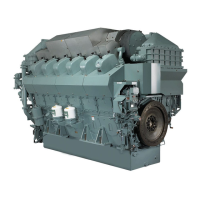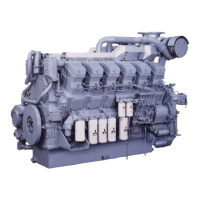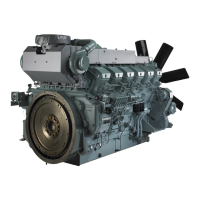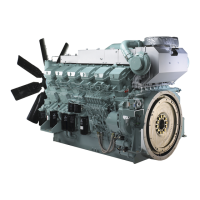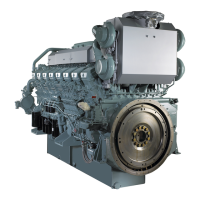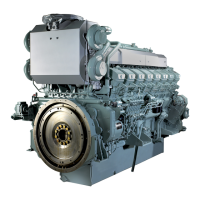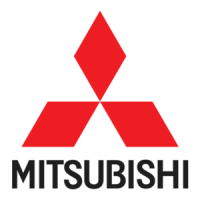
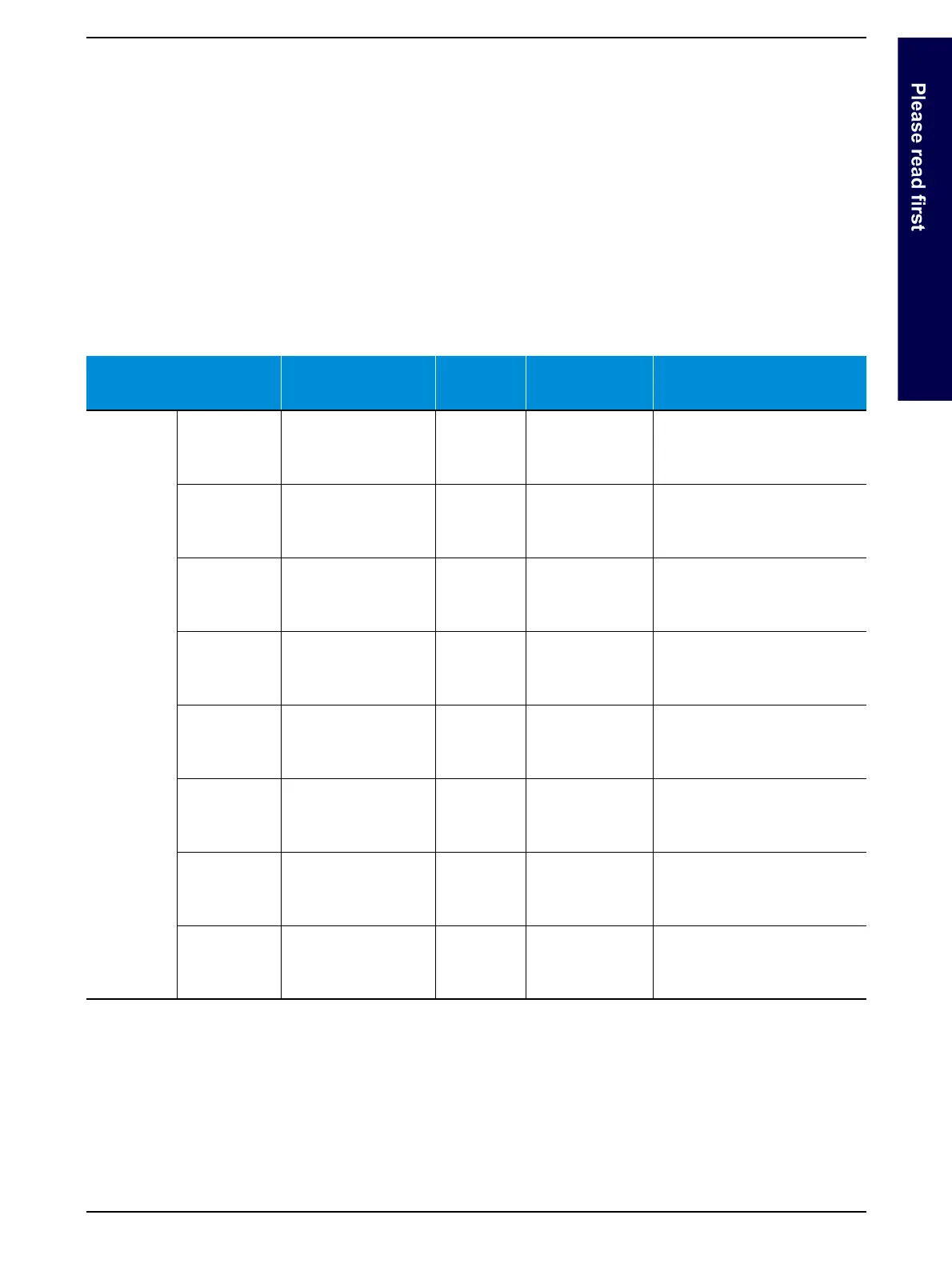
Do you have a question about the Mitsubishi S12R and is the answer not in the manual?
| Engine Model | S12R |
|---|---|
| Fuel Type | Diesel |
| Starting System | Electric starter |
| Aspiration | Turbocharged |
| Lubrication System | Forced lubrication |
| Cooling System | Water-cooled |
Important safety warning statement regarding diesel engine exhaust for California.
Details the engine's suitable applications and intended purposes.
Outlines general rules for operation, inspection, and maintenance.
Essential safety guidelines and precautions for personnel working with the engine.
Outlines the responsibilities of the user company for safe operations.
Key tips for establishing and maintaining safety management systems for engine operations.
Information about the manual's intended audience, copyright, and usage.
Lists engine parts covered under the emission warranty for defects.
Defines the owner's responsibilities regarding maintenance and proper use of the engine.
Section for recording detailed specifications of the engine and its body.
Fields to fill in specific details about the engine's physical characteristics and intended use.
Lists various optional equipment that can be part of the generator system.
Placeholder to compile information about protective devices installed during generator manufacturing.
Explains how to achieve and maintain a Zero Energy State for safe maintenance.
Outlines procedures for working safely in areas with potential hazards.
Details required clothing and protective gear for operator safety.
Covers precautions related to chemicals and surface temperatures of the engine.
Guidelines for creating emergency action procedures for rescue and assistance.
Emphasizes informing operators about emergency stop procedures.
Procedures to follow in case of personal injury caused by the engine.
Actions to take if the engine sustains damage during operation.
Steps to take in case of environmental damage caused by waste oil discharge.
Procedures to follow in the event of a fire caused by the engine.
Actions to take if an earthquake occurs during engine operation.
Guidelines for establishing occupational health and safety management systems.
Importance of safety education and training for personnel.
Information on health and safety hazards associated with chemical substances.
Information on noise levels and the need for hearing protection.
Notes on vibrations and their potential effects.
Importance of maintaining a clean and tidy work environment to prevent accidents.
General fire prevention measures and precautions.
Importance of communicating safety concerns and information with MHIET.
Guide to identifying engine parts by referring to specific pages for different engine types.
Illustrations and names of parts for specific S12R engine models.
Identifies the locations of various protection systems on specific engine models.
Illustrations and names of parts for specific S12R engine models.
Illustrations and names of parts for specific S12R engine models.
Information on starting and stopping devices as installed during generator manufacturing.
Overview of operation methods based on intended use and starting system.
Daily checks to be performed on the engine before or during operation.
Essential checks to perform before starting the engine.
Procedures for starting the engine using different starting systems.
Guidelines for warming up the engine before applying load.
General procedures and precautions for operating the engine.
Key items to check while the engine is running.
Procedures for cooling down the engine before stopping.
Steps for safely stopping the engine.
Information on fuel quality standards and proper fuel handling.
Details on using diesel fuel for emission-controlled engine models.
Precautions for safe handling and storage of fuel.
Guidelines for selecting and using engine oil, including quality standards.
Safety precautions for handling, storing, and disposing of engine oil.
Specifies the water quality required for coolant mixtures.
Guidance on using the correct Long Life Coolant (LLC).
Safety precautions for handling coolant (LLC), including protective gear.
Procedures for maintaining LLC concentration and replacement periods.
Steps for mixing coolant with water according to specified concentrations.
Details on LLC concentration requirements based on ambient temperature.
Instructions on how to measure LLC concentration using a coolant tester.
Guidance on how to use the scheduled maintenance chart and respond to abnormalities.
Explains the categories for scheduled maintenance based on engine use.
Maintenance schedule specific to continuous use engine applications.
Maintenance schedule specific to emergency use engine applications.
General information and precautions for inspection and maintenance tasks.
Steps to prepare before performing inspection and maintenance work.
Procedures for checking the engine body, including belts and dampers.
Inspection and service procedures for the fuel tank, system, and filters.
Procedures for checking and changing engine oil and filters.
Inspection and maintenance procedures for the cooling system, including cleaning and flushing.
Inspection of turbocharger, exhaust muffler, pre-cleaner, and air cleaner.
Procedures for checking the battery and starter.
Procedures for checking starting air systems and components.
How to check belt status, tension, and damage.
Step-by-step instructions for adjusting alternator belt tension.
External appearance check of the damper.
How to check damper temperature using thermo labels and guidelines.
Instructions on applying and reading thermo labels for damper temperature monitoring.
Checks for fuel tank, fuel supply valve, and fuel pipes.
Procedures for cleaning and draining the fuel tank.
Steps to clean the fuel tank and refill with fuel.
Procedure to bleed air from the fuel system.
Instructions for operating the priming pump (A-type and B-type).
Procedures for draining water and replacing the water separator element.
Steps for cleaning the gauze filter.
Instructions for replacing the fuel filter, including bleeding air.
Checking the fuel control link for smooth movement and looseness.
Checking fuel pipes and clamps for wear and proper installation.
General checks for the engine oil system.
Step-by-step guide for changing engine oil.
Instructions for refilling engine oil to the correct level.
Procedure for checking the engine oil level using the dipstick.
Steps to follow after changing the engine oil.
Instructions for replacing the oil filter.
Procedure for replacing the bypass oil filter.
Steps for replacing the governor oil filter for hydraulic governor specifications.
Checking oil pipes for wear and clamp condition.
General checks for the cooling system, including coolant handling.
Procedure for cleaning the engine's cooling system.
Steps to flush the cooling system after cleaning.
Procedure to bleed air from the cooling system.
How to check and clean the radiator fins.
Inspection of turbocharger, exhaust muffler, pre-cleaner, and air cleaner.
Procedures for checking the turbocharger's condition.
How to drain water from the exhaust muffler.
Procedures for checking and cleaning the pre-cleaner.
How to check the pre-cleaner for blockages.
Procedures for checking and cleaning the air cleaner.
How to check the air cleaner for blockages.
Procedures for checking the battery and starter.
How to check the battery fluid level and specific gravity.
Visual check of the starter motor for damage.
Procedures for checking the alternator for damage and rotation.
Checks for air starter strainers and tanks.
Procedures for draining water and cleaning the air strainer.
Checks for the starting air tank and safety valve operation.
Procedures for checking the starting air motor for damage and dust.
Steps for preparing the engine for storage of 3 months or longer.
Measures to prevent rust and corrosion during long-term storage.
Steps for physically storing the engine, including battery and desiccant.
Routine checks and maintenance required while the engine is in storage.
Procedures for preparing and restarting the engine after long-term storage.
Safety precautions and legal requirements for transporting the engine.
Safe procedures for lifting and handling the engine unit.
Safety precautions to be observed before and during troubleshooting.
General advice on fault remedies, advising to contact MHIET for complex issues.
Steps to take before attempting any remedies for faults.
Precautions to prevent contamination during disassembly.
Guidelines for handling engine parts, emphasizing genuine parts.
Safe practices to follow during troubleshooting and repair work.
A systematic approach to diagnosing and resolving engine problems.
Identifies causes and remedies for starting failure due to slow or no cranking.
Lists causes and remedies when the starter cranks but the engine fails to start.
Diagnoses and resolves issues related to reduced engine output.
Addresses causes and remedies for black or dark grey exhaust smoke.
Identifies causes and solutions for excessive fuel consumption.
Diagnoses and resolves issues related to excessive engine oil consumption.
Addresses causes and remedies for engine overheating.
Diagnoses and resolves issues related to engine oil pressure drop.
Procedures for restarting the engine after it has stopped unexpectedly.
Steps to take when the thermo switch activates during normal operation.
Details on the supply period and availability of repair parts.
Information on parts whose supply period has ended.
Steps to follow when requesting engine repair services.
Information required for contacting MHIET for repair and maintenance inquiries.
General precautions for the safe and compliant disposal of engine materials.
Safe procedures for draining and disposing of fuel.
Safe procedures for draining and disposing of engine oil.
Safe procedures for draining and disposing of coolant (LLC).
Safe procedures for draining and disposing of rust preventive materials.
Safe procedures for draining and disposing of battery fluid.
Procedures for properly disposing of the engine body as industrial waste.
Precautions for disposing of waste cloths and heavy objects like tanks.
Information on handling wastes generated during inspection and maintenance.
Information on using engine oil, quality standards, and handling.
Details engine oil quality standards for Grade CF SAE 30.
Details engine oil quality standards for Grade CF SAE 15W-40.
Details engine oil quality standards for Grade CH-4 SAE 15W-40.
Outlines service limits for engine oil properties to ensure proper lubrication and performance.
Specifies engine oil service limits for emergency use scenarios.
Information on coolant, its requirements, and quality standards.
Details the requirements for Long Life Coolant (LLC).
Specifies the quality standards for LLC based on JIS K 2234.
Details LLC specifications for external appearance, specific gravity, water content, etc.
Details LLC specifications for circulating corrosion, metallic test, property of liquid, etc.
Details LLC specifications for rubber adaptability and storage stability.
Explains the importance and necessity of using LLC in the cooling system.
Describes the function and characteristics of LLC additives.
Lists common abnormalities caused by amine-type LLC.
